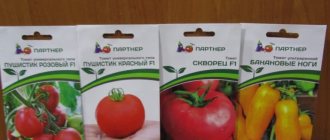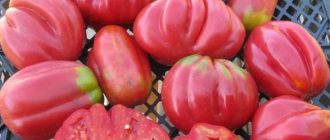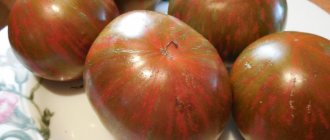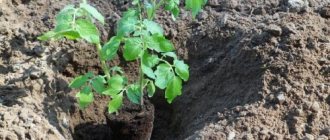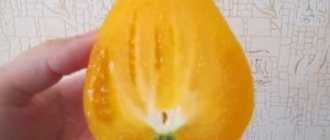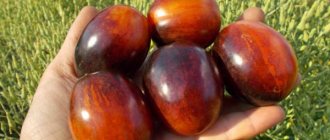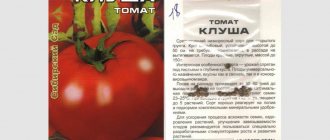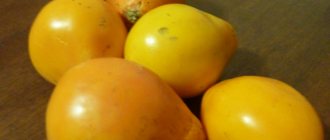Home / Vegetable garden / Tomatoes
Back
Published: November 29, 2018
0
Rate this post
The achievements of selection are impressive, and today gardeners plant not only traditional and familiar round tomatoes, but also popular pepper-shaped tomatoes. This group includes more than a dozen species, differing in color, fruit size, and agricultural technology.
Initially, our hardworking summer residents purchased (or rather “obtained”) foreign varieties and hybrids. But, since 2001, pepper tomatoes of Russian selection have appeared, and here the choice is truly huge. Our review presents the varieties of the variety and provides detailed information with photos, which will allow you to make a more accurate choice.
Let's start with tomatoes that have found a “registration” in the State Register catalog. And the very first among them is the Pepper variety, registered in 2001.
- 1 Pepper
- 2 Yellow
- 3 Orange
- 4 Giant
- 5 Sturdy
- 6 Red
- 7 Raspberry
- 8 Pink
- 9 Striped
- 10 Cuban
- 11 Variety of originals
Pepper-shaped
The originator of the variety is (Moscow region). The bush is tall, powerful, indeterminate type. There is no growth point; in greenhouses the plant reaches 1.8-2 meters.
The tomato is mid-season, the fruits are ready for harvesting after 110-115 days. The shape of the tomatoes is a cylinder, with slight ribbing. Some unripe fruits have a green spot near the stalk; the tomatoes themselves are light green; when ripe, they are bright red. The weight is small, 80-100 grams, although there are larger specimens.
The pulp is fleshy, inside there are two chambers with a small number of seeds. The walls are dense, which makes them suitable for preparing stuffed dishes. The taste is good, the use is universal.
Farmer reviews
Those summer residents who grew the crop in their garden leave positive reviews. Here are some of them :
Anna, Omsk : “I usually plant tomatoes of Siberian selection. But this summer I decided to experiment. The weather was not great, but the Peppers were a great success: sweet, no acid, meaty flesh. There are few seeds. And the vegetables themselves are so beautiful and unusual. They can be used everywhere – both for freezing and drying, and smaller ones can be preserved whole.”
Natalya, Moscow : “I planted a tomato in a greenhouse. The bushes reached two meters. The vegetables ripened unusually, elongated, in the form of huge icicles. And at the break of the pulp the sugar comes out. Themselves juicy and sweet. It’s very convenient to cut them into sandwiches.”
Yellow
In 2007, two interesting tomatoes appeared in the State Register, including Pepper Yellow.
The tall indet impresses with the power of the plant and its large dark green leaves. The foliage is small, the stem height is 1.7-1.9 meters.
After 115-117 days, the first tomatoes are harvested. This variety is suitable for greenhouses and open ground. Leave one trunk, removing all side shoots. In terms of yield, the indicators are not particularly high - up to 3-3.5 kg per square meter, but this variety is valued for the excellent taste of the fruit.
The inflorescences are simple, the fruits are similar to their “brother” - the red pepper tomato. Their walls are dense, and there are small ribs on the surface. The color is bright yellow.
Peculiarities:
- Wonderful taste;
- drought resistance;
- resistance to TMV, various types of rot;
- long fruiting period.
The tomato is demanding of good lighting and soil fertility. The originator is the famous breeder L.A. Myazina. Tomatoes are used in salads, ideal for canning and pickling.
Reviews
Reviews of the Orange Pepper tomato are mostly positive. Summer residents like both the high yield and the appearance of the fruit. But the taste seems to the authors of some reviews not good enough: there is not enough juiciness. In addition, some of the buyers of seeds from Agros were lucky to run into a mismatch.
In recent years, the usual image of tomatoes has been changing, taking on bizarre forms. The variety of varieties reaches fantastic levels, although two decades ago this seemed completely impossible. The color scheme and unique appearance turn an ordinary tomato into an exotic vegetable. Imagine for yourself, a large elongated red pepper actually turns out to be a tomato! Or it looks like a small black bunch of grapes, but it tastes like a cherry tomato!
So, we invite exotic lovers to get acquainted with a unique variety - the Pepper tomato.
Orange
The orange pepper tomato is distinguished by the original color of its fruit, which is also valued for its high yield (up to 9-10 kg per square meter). In the State Register of the Russian Federation - since 2007.
Belongs to the type of indeterminate tomatoes, the bush is vigorous and tall (up to 1.8 meters). In Siberia and other harsh regions it is planted in shelters; in the south it bears fruit well in ridges. The best option is to use it in a shelter to support a trellis. Grow the Orange bush in 1-2 stems, tying the clusters when the fruits ripen on them.
Quite large fruits weigh 150-170 grams; when growing the plant without additional stems, tomatoes weigh up to 280-300 grams. The skin is dense, but without rigidity, the flesh is fleshy and tender. The taste of the tomato is excellent. The use is universal, and this is also one of the advantages of Pepper Orange.
The “advantages” of the variety include:
- unpretentiousness;
- low susceptibility to disease;
- long fruiting.
Judging by reviews from gardeners, Orange’s fruits are suitable for canning as a whole. They look beautiful mixed with green cucumbers, red and yellow tomatoes.
Care after transplant
Caring for tomatoes after transplantation is completely standard and consists of the following procedures:
glaze. It should be taken into account that tomatoes do not tolerate both drought and waterlogging of the soil. They feel best in warmth, with air humidity of about 50%, but on moist soil. Watering should be done as the soil dries, usually once a week, and twice as often in dry weather. To help tomatoes absorb water better, it is recommended to create a trench along the bed and pour water into it. For irrigation, it is best to use settled water heated in the sun. Water consumption rate: 3 liters for low-growing varieties, 8–10 liters for tall ones;
The essence of drip irrigation is the dosed supply of water directly to the root system of plants.
loosening. It is carried out after each moistening, but at least once every 2 weeks to preserve moisture in the soil and to allow air to flow to the roots of the plant. Loosening should be carried out to a depth of 5–8 cm. Deeper loosening can lead to damage to the roots; fertilizing The first fertilizing is carried out during the process of planting seedlings in the ground, adding a handful of compost, humus or ash to each hole. 2 weeks after planting, fertilize with an infusion of organic matter; during mass flowering of tomatoes, use nitrophoska (1 tablespoon per 10 liters of water), and during active ripening of fruits - superphosphate (2 tablespoons of fertilizer per 10 liters of water)
When organizing fertilizing, it is important to take into account the condition of the plants, soil fertilization, weather quirks and your own experience;
To feed tomatoes, use an infusion of crushed nettle, coltsfoot, dandelion, woodlice, plantain, and celandine.
garters of the stem to the trellis.
We begin tying up tomatoes 2–3 weeks after planting seedlings in open ground or a greenhouse
Particular attention should be paid to pinching and stem formation of especially tall varieties. If you leave the side shoots (side shoots in the initial stage of growth) on the stem, they will grow, take nutrients from the plant and, as a result, the bush will not bear fruit.
Be prepared that you will have to deal with pinching pepper varieties all summer.
For their development, stepchildren use the beneficial substances of the plant, so the sooner they get rid of them, the better
A bush of tall pepper tomatoes must be formed into 1–2 stems. Stepsons must be carried out regularly, at least once a week, until the stepsons become more than 5 cm. If pruning is not done in a timely manner, the plant receives severe stress, and a wound may form in the place of the removed stepson.
Until the stepsons grow more than 5 cm, they break off easily, and the wounds heal quickly
Starting from the end of May, it is necessary to remove not only the stepsons of pepper tomatoes, but also the lower leaves. As soon as fruits begin to form on the cluster, the leaves underneath them are torn off. This should be done gradually, removing no more than 3-4 leaves per week. Otherwise, the plant will experience stress, which can lead to stunted growth and loss of yield.
The leaves can be cut off or broken slightly to the side so as not to remove part of the peel from the stem
As you can see, growing pepper tomatoes is not much different from the procedures for planting and caring for conventional varieties. Include this interesting variety in your collection! Pepper-shaped fruits will surprise you with their appearance, taste, and will serve as decoration for your table.
Giant
2007 is the time when the Pepper-shaped giant tomato appeared in the State Register.
The characteristics and description of the variety are identical to the tomatoes described above, the differences lie in the configuration of the fruit and color. The Giant's tomatoes are slightly elongated, deep red in color, weighing up to 200 grams. 1-2 stems are left on the bushes; pinching is required. The clusters produce 5-9 fruits, the total yield is 5.5-6.5 kg per square meter.
The skin is hard and glossy. Fruits with dense fleshy pulp, 3-4 chambers inside, few seeds. The taste of tomatoes is good, this is noted by everyone who planted the Pepper-shaped Giant on their plot.
Where to use tomatoes? In salads, they are also tasty when pickled or preserved. Housewives freeze and dry it, and use it for stuffing.
Growing rules
Pepper tomatoes are suitable for open ground, but can also grow in greenhouses. The soil should be neutral or slightly acidic. If the soil is quite acidic, it is recommended to treat the planting site with lime, which will reduce the acidity. The best option is loam.
Planting seedlings
The timing of sowing depends entirely on the region in which the planting takes place. In any case, seedlings are transferred to open ground after the end of frost. Seedlings should grow for 45-65 days.
Since this variety is a hybrid, the seeds must be purchased in stores every year; you cannot collect them yourself. Before planting, the seeds are soaked. If necessary, you can make the soil yourself or purchase a ready-made one.
In the container for seedlings, grooves are made with a depth of no more than 2 cm, so that the root mass quickly grows; it is recommended to pick. The picking process is carried out at the moment when the first leaves appear. After 6 full leaves appear on the bushes, it can be planted in open ground.
Tomato transplant
Tomatoes love sunny, wind-protected areas. Considering that the Pepper-shaped variety is capable of growing more than 2 m, then it is worth taking care in advance about trellises for gartering bushes. Before planting seedlings in open ground, it is recommended to apply fertilizer - manure. It is allowed to plant up to 4 bushes with 2 stems per square. If you plan to place more roots in such an area, then the stem should remain alone.
Important! The depth of the hole should be 15*15 cm in size.
Subsequent care for tomatoes
Caring for Pepper tomatoes is not as difficult as it might seem at first glance. It is necessary regularly:
- Water.
- Loosen the soil.
- Pinch.
- Tie up the stems in a timely manner.
To water the seedlings less often and avoid loosening, you need to scatter mulch, straw or dry grass around the bush. The mulch layer should not be less than 5 cm.
During stepsoning, the stepsons are removed from the bush. This method allows you to form tomatoes into 1-2 stems. Throughout the season, fertilizing is applied up to 3 times. Manure or droppings are used for this. In early August, the tops are pinched off.
Sturdy
In 2014, the catalog of the State Register was replenished with a new tomato from Altai breeders - Pepper-shaped robust. From all his “relatives” already registered on the list, he stood out in height. Tomato: Pepper-shaped, robust, determinate type, no more than 30-40 cm in height.
The bushes are compact, with little foliage; plant shoots are not removed. But remember that a tie to the support in the beds is required, since the branches break off under the weight of the fruit. Yield indicators are up to 4-4.5 kg per square meter. The first pepper tomatoes are harvested after 105-107 days.
The fruits are elongated, weight – 120-140 grams, there are three chambers inside. There are few seeds. The color of the skin in a state of technical ripeness is green, when ripe it is dark crimson. Some fruits have a dark burgundy spot near the stalk.
Gardeners note the excellent taste, which, however, is typical for all tomatoes in this group. The fruits are suitable for pickling, winter salads, and for processing. The “advantages” of Krepysh include:
- compactness of plants;
- disease resistance;
- unpretentiousness;
- good tomato taste.
The variety is good for Siberia, the North-West, and the Urals, where the warm season is short and the summer is often cool.
Red
In 2015, the Pepper-shaped Red (agro) variety was registered in the State Register. The plant reaches a height of almost two meters, has long leaves, and forms complex inflorescences. In terms of timing, it is a mid-season tomato, which is quite suitable for both the middle zone and the northern regions. Pepper-shaped tomatoes, with a ribbed surface, look like red sweet peppers. Weight – 120-150 grams.
Description of tomatoes: ripe fruits of bright red color, glossy, dense skin. The pulp is fleshy, the number of chambers is 3-4. The taste of tomatoes is excellent, with good yield indicators - up to 2.5-3 kg per bush. Like many other tomatoes with fruits and peppers, Red is used for canning, pickling, and eaten fresh.
Nuances for open and protected ground
The variety is recommended for cultivation in open ground in the southern regions and in greenhouse conditions in the northern regions . In the middle zone, it is necessary to have covering material on hand in case of a sharp drop in temperature or prolonged rains.
When the temperature drops unexpectedly, the tomato is fed with calcium ions . This is especially necessary when setting fruit, since in cold air they are affected by fungal diseases, for example, blossom end rot. Feeding with calcium protects the ovaries from fungus.
Stop watering 2 weeks before the vegetables ripen , as the increased amount of moisture may cause the fruits to crack.
In August, the tops of plants are pinched . This not only prevents further growth, but also prevents new inflorescences from forming.
Crimson
The variety from Siberian breeders called Pepper Raspberry is intended for cultivation in the open air. You can plant it under shelters; arcs or greenhouses are suitable. The beautiful fruits are suitable for all types of processing, tasty fresh and in pickles.
The tomato is a determinate type, low, reaching a height of 40-50 cm in the garden. The fruits are both similar to sweet peppers and elliptical, with a very smooth glossy skin of raspberry-purple color.
Inside the fruits there are 4-6 nests, there are few seeds. The weight of tomatoes reaches 150 grams, but with special care you can grow fruits up to 250 grams. The pulp is fleshy, sugary, pleasant taste.
Variety value:
- early ripeness (100-102 days);
- excellent taste of tomatoes;
- good yield indicators (up to 8 kg per square meter in beds, up to 15 kg in greenhouses);
- resistance to cold weather.
Tomato varieties from Siberian breeders are adapted to harsh local conditions, and they will delight you with abundant fruiting and good taste.
Classification of tomatoes by type of cultivation
Varieties for open ground
Most categories of tomato seeds are suitable for growing in open ground. The summer resident needs to take into account the region of residence, climatic conditions and the versatility of the proposed variety.
Rating of the best seeds for planting tomato seedlings for open ground:
- Tomato "Orange". An unpretentious variety with an ideal harvest: the fruits in a bunch ripen evenly, have a yellow color and a round shape, weigh approximately 150-200 g. The tomatoes are dense and juicy, while they have few seeds. Suitable for any type of dish, preparing pasta and salting. Bushes must be tied up in a timely manner.
- "Dietary big guy." Juicy, sweet orange tomatoes. Early ripening variety with long shelf life. The 1 m high bush needs support due to the large number of brushes. The fruits are large, approximately 300 g each.
- "Gigolo." Fleshy tomatoes with thick skin and a sweet flavor. The variety is productive, stores well, and bears fruit before the onset of cold weather. The bush does not need support and takes up little space in the garden bed.
- "Golden heart". An early-ripening variety of orange, heart-shaped tomatoes. The pulp is juicy, rich yellow. The bush is compact, approximately 50-80 cm, does not require pinching.
- "Heart of a Buffalo" A productive variety suitable for canning and making tomato paste. Loose, heart-shaped fruits, with thin skin and juicy raspberry-colored pulp, weigh 200-250 g. The variety is distinguished by long-term fruiting and resistance to various diseases. The bush is low-growing, spreading, and does not require pinching.
The best varieties of tomatoes for greenhouses and greenhouses
To get a good harvest, it is recommended to grow tomatoes in greenhouses and greenhouses. Below are proven varieties that will provide summer residents with ripe and at the same time fleshy tomatoes.
Rating of tomato varieties for greenhouses with descriptions:
- "Antonovka honey" An unusual subspecies of tomatoes with thick green skin and bright pink flesh. The fruit tastes sweet, with a honey flavor. Suitable for both fresh consumption and preservation. They are unpretentious in care, but require pinching and tying up. In greenhouse conditions, bushes grow up to 1.5 m.
- "Marshmallows in chocolate." Brown-red fruits with thin skin and juicy pulp. The vegetables are sweet and suitable for slicing and making tomato paste. The variety bears fruit before the onset of the first cold weather. The harvest is stored for a long time. The height of the bush does not exceed 1.7 m in height.
- "Golden domes". Mid-season tomato variety with yellow fruits. The tomatoes are juicy and fleshy, weigh from 200 to 400 grams, and can ripen indoors when picked green. The height of the bush is 1.6 m.
- "Malachite Box". A green type of tomato with an unusual fruity flavor. The pulp of the fruit is tender, practically without seeds. The height of the bush reaches 1.5 m, and there are many fruits. Average weight of tomatoes: from 80 to 200 g.
- "Citrus Garden" A variety of yellow tomatoes that will provide the summer resident with a rich harvest. The fruits are oval in shape, with a thick peel, ideal for pickling. The bush can reach a height of 2 m, but it needs pinching and timely watering.
Varieties for growing on the balcony and at home
Tomatoes can also be grown at home, the main thing is to choose the right varieties for this purpose. Rating of the best tomato seeds for planting on a balcony or windowsill:
Tomato "Bonsai". Early ripening cherry, forming bushes 30 cm high. The fruits are tasty, round in shape, weighing 20 g. Productivity per bush - up to 1 kg.
"Room Surprise" A variety characterized by elongated vegetables weighing 30-40 g
It is important to provide the plant with light during the period of growth and formation of ovaries.
"Pinocchio". The most productive indoor variety - from one bush you can get up to 1.5 kg of round, bright red fruits.
Pink
The originator of the variety is a well-known agricultural company that supplies seeds of a wide variety of tomatoes to the market. The variety also produces seeds. Pepper pink was registered in the State Register in 2018, so it can be called a new product.
The bushes are tall (up to 1.6 meters), with medium foliage. Stepchildren are removed from the plant and must be formed. Most often, two stems are left (this results in higher yields).
Tomatoes are elongated, with a miniature “tail”. The pink skin is dense, but thin, with a shine. The weight of the fruits is equal, approximately 80-100 grams. Those who have already grown the variety note its balanced taste and aroma. The tomato is a mid-season variety, the first fruits are harvested after 105-110 days, the average yield is 6-7 kg per square meter.
Striped
For lovers of original varieties, we recommend the Striped Pepper tomato. Its fruits are red-orange with golden shading, great for salads and canning.
The plant is low (up to 60-70 cm), squat, heavily leafy. Due to its compactness, tomatoes are planted densely in beds, up to 7-8 plants per square meter. meter.
Typically, this tomato is formed into 3-4 stems, since the main stem quickly completes the growth of a flower cluster. Each bush bears 4-5 clusters, each containing up to 8 fruits.
In terms of productivity, this variety is inferior to other pepper tomatoes, but it has a different value - the unusual color of the fruit.
According to reviews, the taste of tomatoes of the Striped Pepper variety is good, but there are voids in the pulp. This canned tomato is great; the preparations look elegant. It does not lose its shape in marinades and brine, and the skin does not crack.
Specifics of cultivation
Growing tomatoes is quite simple. Seedlings are planted in a permanent place at the age of 60-65 days, 3-4 bushes per square meter.
Seedlings (at the age of 60-65 days) are planted in a permanent place at a density of 3-4 bushes per 1 m2
Further care comes down to pinching, tying and pinching stems, loosening the soil, preventative treatments for diseases, watering and fertilizing. The plants do not require any additional effort or special agrotechnical techniques. Considering the stable yield and versatility of fruit use, the variety can be recommended for cultivation even by inexperienced summer residents.
Cuban
This variety is not included in the State Register, which in no way detracts from its value. In catalogs of tomato collectors, Cuban is found under other names: Pepper-shaped black, Cuban black. Those who prefer large-fruited tomatoes should not miss this variety.
The most attractive thing is the fruits, large, weighing up to 300-350 grams and very similar to juicy sweet peppers. The dense skin is dark red, almost black at the stalk, the flesh is fleshy, there are very few seeds.
Everyone who planted the variety speaks positively about the taste of these tomatoes. It is not suitable for preparations; the best use is fresh and in salads. The plants are tall, reaching 2.2-2.4 meters in shelter. The bushes must have stepsons, leading the plants into two stems, leaving an additional stepson.
ON A NOTE! This tomato is medium late, so in regions with harsh climates it is grown only in greenhouses.
For 1 sq. 2-3 bushes are placed per meter. It takes a long time to bear fruit, and what is important is that the tomato is resistant to infections.
How to grow seedlings
Sowing seeds for seedlings begins 2 months before planting in the ground . Before sowing, the seeds undergo special preparation.
Seed preparation
The photo shows a pink peppercorn tomato.
The seed material is laid out on the table one at a time and carefully inspected for visible defects. It is then checked for emptiness by immersing it in a saline solution for 10 minutes.
Those seeds that float to the surface are not suitable for planting. The remaining grains are placed in a weak manganese solution for 30 minutes. In this way, the grains undergo disinfection, which has a positive effect on the further development of the seed material.
To improve germination, seeds are soaked for 10 hours in a growth stimulator. The swollen ones can be sown in the ground.
Attention! High-quality seed preparation ensures healthy seedling growth.
Container and soil
The soil is prepared from turf soil and humus in equal quantities. A little washed river sand, 1 teaspoon of superphosphate and 3 teaspoons of wood ash are added to the resulting mixture. After thoroughly mixing all the components, the soil mixture is poured with a hot solution of purple potassium permanganate or steamed in the oven at a temperature of 50°C for 15 minutes.
Reference. Disinfection of prepared soil destroys pathogenic microorganisms that are destructive to seedlings.
The cooled soil is laid out in planting containers , filling them two-thirds. Small drainage holes are made in advance at the bottom of the containers to ensure the drainage of excess moisture.
You can plant in a common wooden box and in separate containers, for example, plastic cups, peat pots or paper honeycombs.
Sowing
Seeds are sown to a depth of 1.5 cm with a distance of 2-3 cm from each other . Sprinkle the soil on top, compact it and lightly water it with warm, settled water using a spray bottle. The planting containers are covered with film and left in a warm room at a temperature of 25°C. The film is removed daily to ventilate and moisten the soil as it dries out.
Seedling care
When shoots appear, the film is removed and the containers are moved to the windowsill . Daylight hours for seedlings are at least 12 hours, so additional lighting is installed if necessary.
Water moderately with warm, settled water along the edges of the containers using a shallow watering can. After watering, the soil is loosened carefully, without touching the young roots.
When 2 true leaves appear, the seedlings dive , planting them in separate containers. The picking procedure means shortening the main spine by one third. After picking, the seedlings grow more intensively.
Advice! If growth is poor, seedlings should be fed with liquid fertilizer for tomato seedlings.
2-3 weeks before planting in the ground, the sprouts are hardened by taking them out into the open air for 1 hour. Gradually, the time spent on the street is increased to 12 hours. At the same time, the night temperature in the room where the seedlings are brought is reduced to 13°C.
